If someone were to do a web search for "shootings in Ohio," thousands of reports of gun violence would immediately appear – some dating back decades – describing accounts of death and despair. This tragic and persistent pattern reveals a deeper issue: the imbalance of power between state and local governments, and the limits of federalism in protecting public safety.
Regardless of the current legal framework, individualized gun restrictions are a necessity in cities that experience large-scale gun violence, such as Cleveland, Cincinnati and Columbus. In 2024 alone, there were 228 people shot in Cincinnati and 247 in Columbus, with similar numbers in Cleveland. That equates to approximately 0.62 people shot per day across just these two cities, or more than one person shot every two days.
Shootings are not isolated incidents; they leave behind deep psychological scars and ripple effects that traumatize entire communities. As noted by Julie Collins and Emily Swoveland in Children’s Voice, these events cause long-term psychiatric stress. When state leadership refuses to respond with adequate reform, the duty to act falls on local governments.
Fortunately, Ohio’s Constitution provides a mechanism for local empowerment.
Article XVIII, Section 3 grants all municipalities the authority to exercise “all powers of local self-government.” This clause affirms the principle of home rule – an acknowledgment that local governments should be able to enact measures necessary to protect their citizens. Moreover, police powers hypothetically authorize local governments to regulate the health, safety and welfare of their communities, which should encompass localized gun legislation, according to Section 2935.03. Allowing cities to respond to their own public safety needs does not inherently conflict with state law; it complements it by enabling government at every level to function effectively for its people.
Those in opposition point to State Statute: Ohio Revised Code § 9.68, which declares the General Assembly’s intent to regulate firearms uniformly across the state. This preemption law, along with the Ohio Supreme Court’s decision in Cleveland v. State, upheld the statute and ruled that it constitutes a “general law that displaces municipal firearm ordinances” and does not unconstitutionally infringe on home rule authority.
In other words, the court determined that cities cannot pass gun laws more restrictive than those at the state level.
Yet, laws are not static – they are living instruments meant to adapt as society evolves. The Cleveland ruling was issued over a decade ago, and since then, the scale and nature of gun violence have changed dramatically. Courts have revisited precedent countless times when the facts demand it. As communities across Ohio face rising urban gun violence, it is both logical and just to reevaluate the limits of state preemption.
Laws that once seemed uniform and fair may now be barriers to survival.
Even within existing limits, cities already possess specific pathways to act. Uniform state preemption generally applies to the possession, ownership and carrying of firearms, but not necessarily to the use or discharge of those firearms. Historically, ordinances regulating the discharge of a firearm within city limits – especially in densely populated areas – have been treated as a local matter because the state has not enacted a comprehensive, conflicting law on this issue, according to Section 3739.15.
Similarly, municipalities can regulate the improper handling of firearms while intoxicated, focusing on dangerous conduct rather than on the right to own a gun. These distinctions are more than legal nuances; they are lifelines for urban communities seeking practical tools to prevent tragedy.
Enjoy what you're reading?
Signup for our newsletter
The pervasive nature of gun violence in Ohio’s most significant cities presents a clear and present danger to public safety that demands immediate, effective intervention. The state legislature’s reluctance to adapt, paired with the devastating human toll of shootings in cities like Cincinnati, Columbus and Cleveland, underscores why local action is essential.
Ultimately, the goal is not to amend constitutional rights, but to preserve human life. Public safety should remain a priority. The legal landscape is capable of evolution, and when lives are at stake, it must evolve. Courts and lawmakers alike should reconsider the strict application of state preemption to grant Ohio cities the flexibility they need to protect their residents through targeted, evidence-based gun safety legislation. The right to live without fear of gunfire in someone’s community should not depend on the inaction of a distant legislature; it should rely on the courage of cities willing to act.
Julia Rode is a junior double-majoring in economics and political science, with minors in history and international business. She is a student ambassador for the College of Arts and Sciences, a co-founder of Students for Sustainability and a member of Kappa Alpha Pi and Miami's Government Relations Network.




